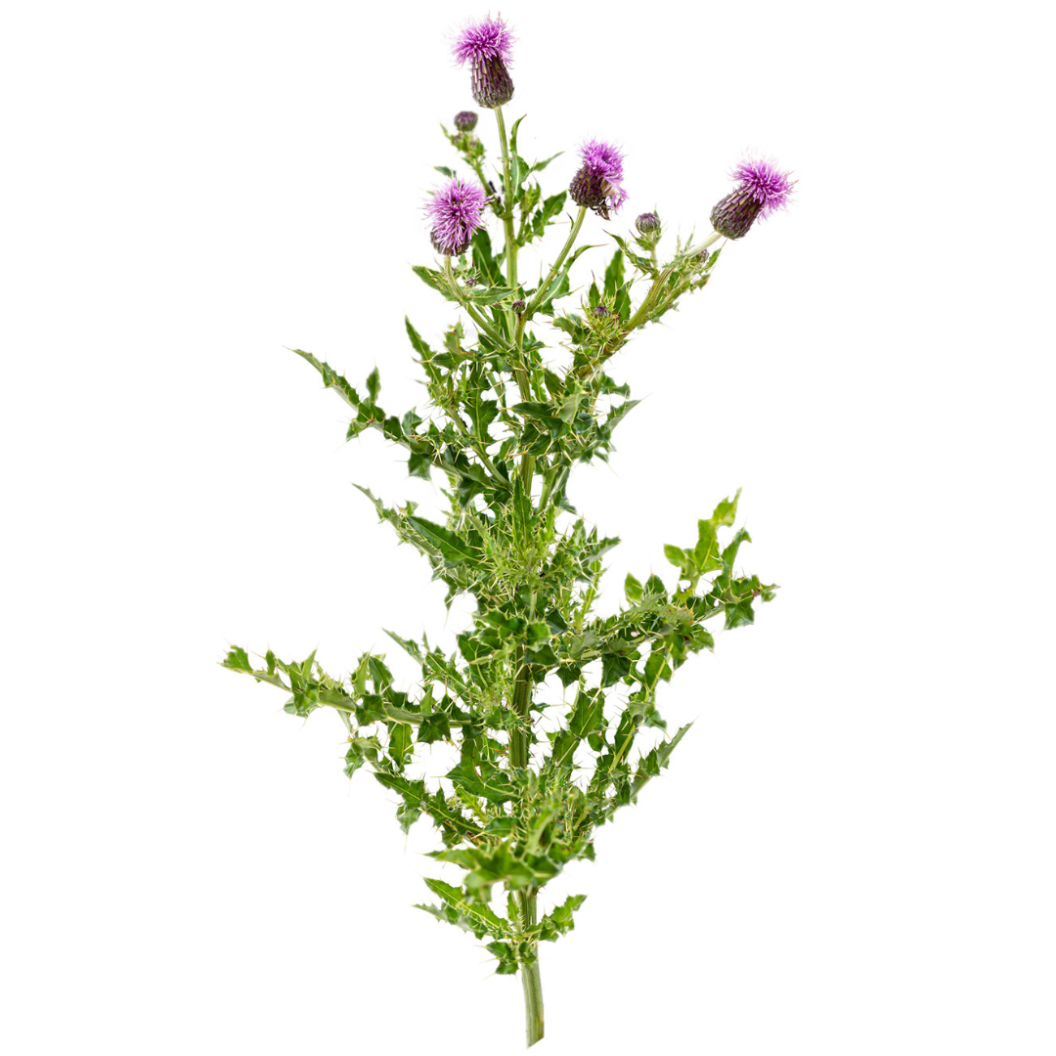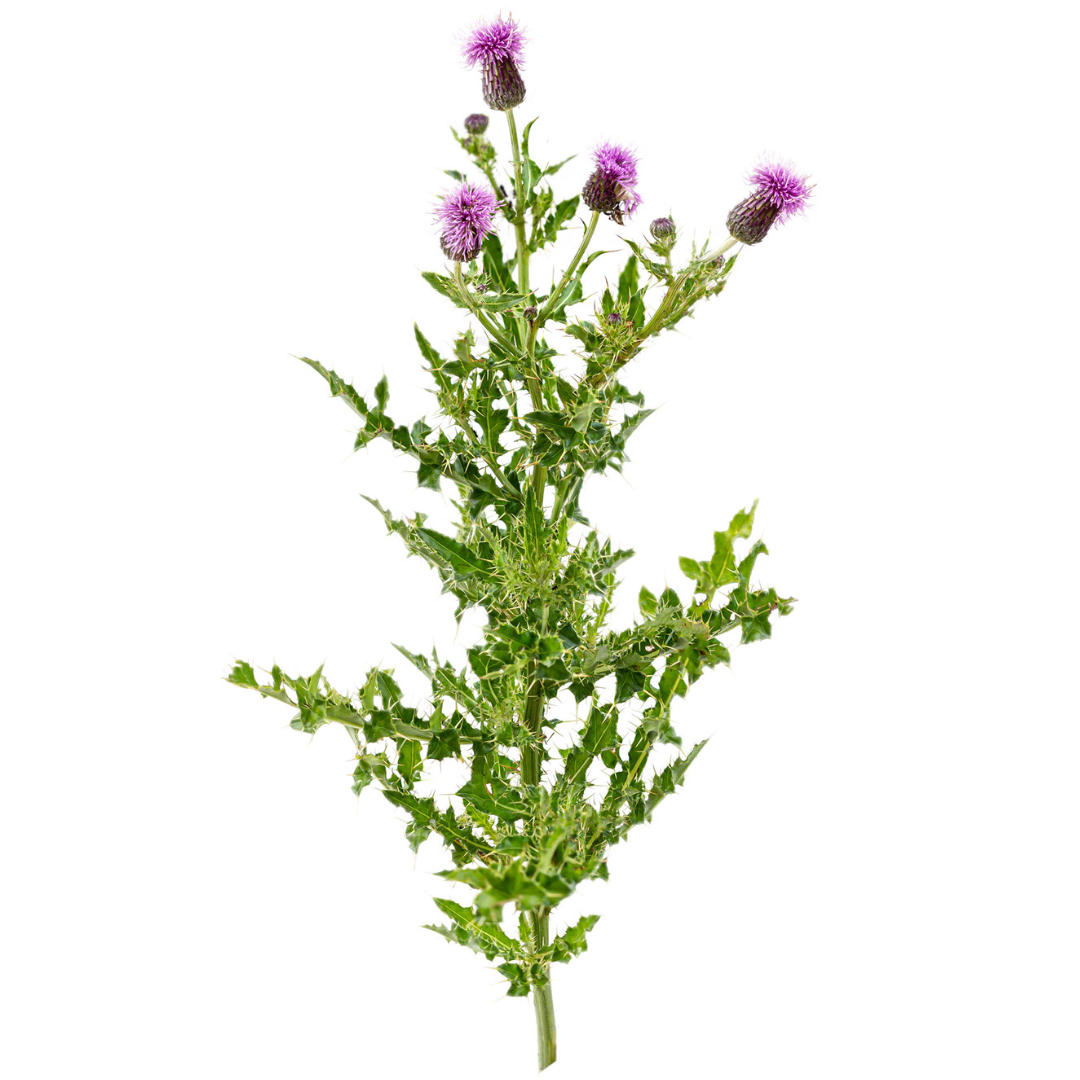
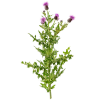


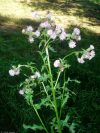
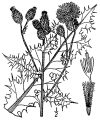
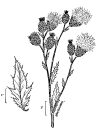
Canada Thistle
DESCRIPTION: Canada Thistle is a weed that grows in much of North America. It has a deep root system and can spread quickly, making it extremely difficult to control. Moreover, the roots can grow both horizontally and vertically. The plant has prickly leaves and stems that are painful to touch, and it produces small pink or purple flowers in the summer. Although it is consider invasive in some areas, Canada Thistle does have some benefits, such as providing food and shelter for pollinators like bees and butterflies.
SCIENTIFIC NAME: Cirsium arvense
OTHER NAMES: Creeping Thistle, Field Thistle, Corn Thistle, Perennial Thistle, Californian Thistle
LEAF TYPE: Broadleaf
FLOWERS: Flowers are small and pink or purple in color. They are arranged in rounded clusters at the top of the stem, and each flower is made up of many tiny individual florets. They are quite distinctive and easy to recognize.
LEAVES: Leaves are long and narrow, with irregularly spaced lobes along the edges. Lobes may be sharply pointed or rounded, and the tips of the lobes often have spiny, tooth-like projections. The leaves alternate along the stem. Their surface will be fuzzy to the touch with a somewhat rough texture.
LIFE CYCLE: Perennial
HOW TO IDENTIFY: The key features to look for are the narrow, spiny leaves and the rounded clusters of flowers that are pink or purple with lots of tiny individual florets. This is probably one of the easiest weeds to indetify once you have seen one before.
MECHANICAL CONTROL RECOMMENDATIONS:
1. Mowing - More Info
2. Tilling - More Info
3. Smothering - More Info
4. Grazing - More Info
5. Hand Pulling - More Info
6. Prescribed Burning - More Info
CHEMISTRY RECOMMENDATIONS:
"Pre-emergent herbicides:
Glyphosate: Although typically thought of as a post-emergent herbicide, glyphosate can also be used as a pre-emergent treatment for some weeds. It is a non-selective herbicide, meaning it can damage or kill a wide range of plants, including Canada thistle.
Isoxaben: Isoxaben is a pre-emergent herbicide that inhibits cell wall synthesis in susceptible plants. It can provide control of certain broadleaf weeds, including Canada thistle, when applied before weed seeds germinate.
Indaziflam: Indaziflam is a newer pre-emergent herbicide that works by inhibiting cellulose biosynthesis in emerging weeds. It can provide residual control of certain broadleaf weeds, but its effectiveness against Canada thistle might vary.
Oryzalin: Oryzalin is a pre-emergent herbicide that works by inhibiting cell division in plants. It can provide control of a range of annual grasses and broadleaf weeds, but its effectiveness on Canada thistle might be limited.
Trifluralin: Trifluralin is a pre-emergent herbicide that disrupts cell division in germinating weed seeds. It can provide control of certain annual grasses and broadleaf weeds, but its effectiveness on established Canada thistle might be limited.
Benefin: Benefin is a pre-emergent herbicide used for controlling annual grasses and some broadleaf weeds. Its effectiveness on Canada thistle might be limited due to the deep-rooted and perennial nature of this weed.
Post-emergent herbicides:
Glyphosate: Glyphosate is a non-selective herbicide that targets a wide range of plants, including Canada thistle.
2,4-D: 2,4-D is a selective herbicide that targets broadleaf weeds. It's commonly used to control Canada thistle and other similar weeds.
Dicamba: Dicamba is another selective herbicide that targets broadleaf weeds.
Clopyralid: Clopyralid is a selective herbicide that targets certain broadleaf weeds, including Canada thistle. It's often used in turfgrass and agricultural settings.
Metsulfuron-methyl: Metsulfuron-methyl is a systemic herbicide that is effective against a range of broadleaf weeds, including Canada thistle.
Triclopyr: Triclopyr is a selective herbicide used for controlling a variety of broadleaf weeds, including Canada thistle. It's commonly used in forestry, rights-of-way, and other non-crop settings.
Aminopyralid: Aminopyralid is a herbicide used for controlling broadleaf weeds, including Canada thistle. It's often used in pasture and rangeland management.
Selective herbicides:
Clopyralid: Clopyralid is a broadleaf herbicide that targets plants like Canada thistle while leaving grasses largely unaffected. It's often used in pastures, rangelands, and non-crop areas.
Aminopyralid: Aminopyralid is another broadleaf herbicide that can be effective against Canada thistle and similar weeds. It's used in a variety of settings, including pasture and rangeland management.
Picloram: Picloram is a herbicide used to control broadleaf weeds, including Canada thistle. It's commonly used in rangeland, pasture, and non-crop areas.
Triclopyr: Triclopyr is a selective herbicide that targets broadleaf weeds, including Canada thistle. It's used in various settings, such as forestry, rights-of-way, and non-crop areas.
Metsulfuron-methyl: Metsulfuron-methyl is a systemic herbicide that can be used to control broadleaf weeds like Canada thistle. It's often used in non-crop areas and might require multiple applications.
Fluroxypyr: Fluroxypyr is a herbicide that targets broadleaf weeds and is used in various settings, including turfgrass and non-crop areas.
Quinclorac: Quinclorac is a selective herbicide mainly used for controlling annual grasses in turfgrass, but it can also have some effect on certain broadleaf weeds like Canada thistle.
Clopyralid + Triclopyr: Some herbicide formulations combine clopyralid and triclopyr to target a broader range of broadleaf weeds, including Canada thistle.
Non-Selective herbicides:
Glyphosate: Glyphosate is one of the most widely used non-selective herbicides. It targets a broad spectrum of plants and is effective in controlling mature weeds, including Canada thistle.
Glufosinate: Glufosinate is another non-selective herbicide used for controlling a variety of weeds, including Canada thistle. It's commonly used in non-crop areas, turfgrass, and some agricultural settings.
Diquat: Diquat is a contact herbicide that desiccates plant tissues upon contact. It's used for non-selective weed control in areas like aquatic environments and industrial sites.
Paraquat: Paraquat is a fast-acting non-selective herbicide that damages plant tissues upon contact. It's commonly used for vegetation control in non-crop areas.
Pelargonic Acid: Pelargonic acid is a natural fatty acid-based herbicide that can be used for non-selective weed control. It's often used in organic gardening and for spot treatments.
Sodium Chlorate: Sodium chlorate is a strong oxidizing herbicide that can be used for non-selective weed control. However, it's considered hazardous to handle and is typically used in industrial or non-residential areas.
Ammonium Nonanoate: Ammonium nonanoate is a non-selective herbicide derived from fatty acids. It's used for contact weed control and is often considered for organic gardening.
Acetic Acid: Acetic acid, or vinegar, can be used as a non-selective herbicide for spot treatments. However, it's less effective on established perennial weeds like Canada thistle.
Recommended Prevention
Recommended Control

